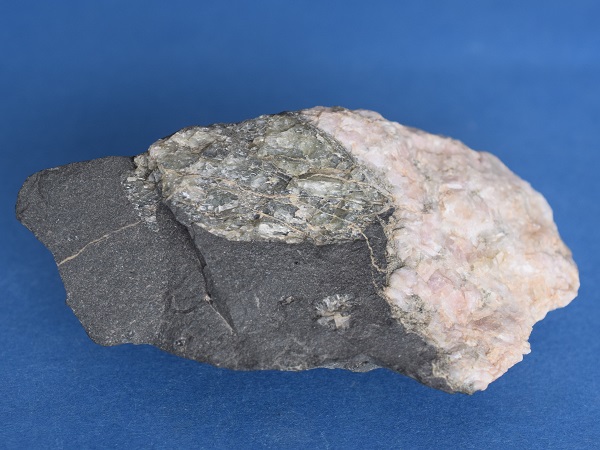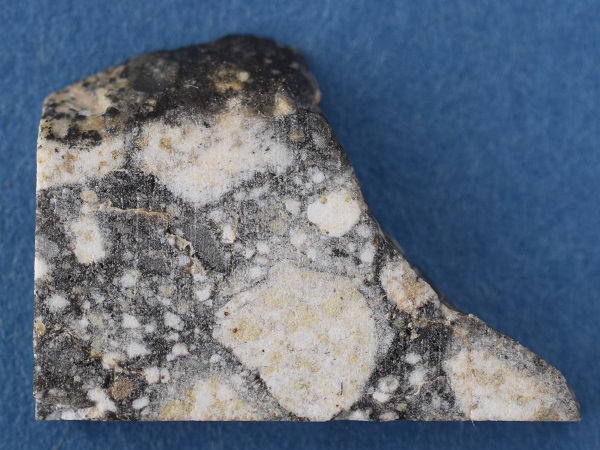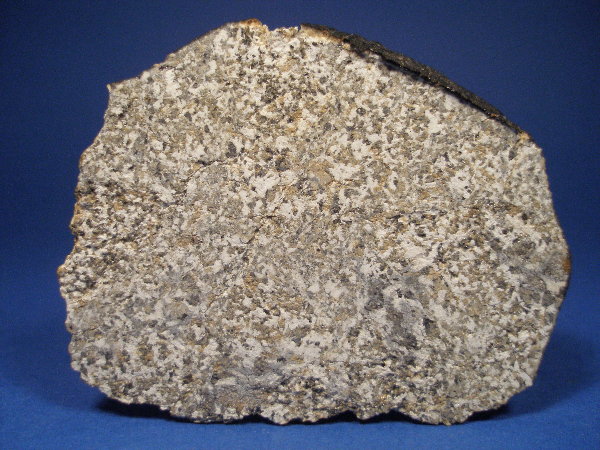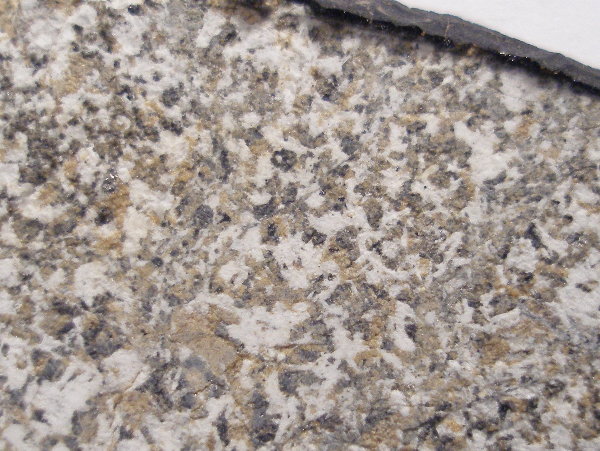Anorthite / Anorthit
CaAl2Si2O8

Large greenish anorthite crystal of 4.5 cm length in lamprophyre with calcite. Diabas quarry Loitsch, Weida, Thuringia, Germany. Specimen size 10.8 cm. Collection and foto Thomas Witzke.
Großer grünlicher Anorthit-Kristall von 4,5 cm Länge in Lamprophyr mit Calcit. Diabas-Steinbruch Loitsch, Weida, Thüringen, Deutschland. Größe der Stufe 10,8 cm. Sammlung und Foto Thomas Witzke.

White anorthite in the meteorite NWA 5000, achondrite, Lunar meteorite (LUN group), anorthitic (feldspathic) leucogabbroic breccia. The rock is a complex lunar highland breccia of leucogabbroic to gabbroic and impact melt clasts in a fragmental to glassy matrix. It is the product of multiple impact brecciation in the ancient, probably more than 4 billion years old crust of the Moon. The light leucogabbro clasts contain anorthite (An 96.1 - 98.0), olivine, pigeonite and accessory minerals. The material was ejected from the Moon by a younger impact into an Earth-crossing orbit. Found July 2007. Southern Morocco. Specimen size 17 x 12 mm, weight 0.74 g. Collection and foto Thomas Witzke.
Weißer Anorthit in dem Meteorit NWA 5000. Achondrit, Mond-Meteorit (LUN-Gruppe), anorthitische Leucograbbro-Brekzie. Bei dem Gestein handelt es sich um eine komplexe lunare Hochland-Brekzie aus Klasten von Leucogabbro bis Gabbro und von Impaktschmelze in einer fragmentalen bis glasigen Matrix. Es ist das Produkt multipler Brekziierung durch Impakte in der alten, wahrscheinlich über 4 Milliarden Jahre alten Kruste des Mondes. Die hellen Leukogabbro-Klasten enthalten Anorthit (An 96.1 - 98.0), Olivin, Pigeonit und Akzessorien. Durch einen jüngeren Impakt wurde das Gestein vom Mond auf eine die Erde kreuzende Flugbahn gebracht. Fund Juli 2007. Süd-Marokko. Größe 17 x 12 mm, Gewicht 0,74 g. Sammlung und Foto Thomas Witzke.

White anorthite and brownish augite in the meteorite NWA 5018. Achondrite, unbrecciated Eucrite. The meteorite NWA 5018 has a basaltic composition (the terrestrial analogue is a gabbro). He shows a coarse-grained texture of brownish pyroxene (augite with Ca-poor exsolution lamella or vice versa, Fs27-64.1, Wo1.2-44.5) and white anorthite (An78.5-91.1). Minor components are ilmenite, Al-Ti rich chromite, and troilite. Source of the material is probably the asteroid 4 Vesta. Found 2007. Northwest Africa (Morocco or Algeria). Specimen size 55 x 44 mm, weight 12.6 g. Collection and foto Thomas Witzke.
Weißer Anorthit und bräunlicher Augit in dem Meteorit NWA 5018. Achondrit, unbrekziierter Eucrit. Der Meteorit NWA 5018 zeigt eine basaltische Zusammensetzung (das terrestrische Analogon ist ein Gabbro). Er weist eine grobkörnige Textur aus bräunlichem Pyroxen (Augit mit Entmischungslamellen von Ca-armen Pyroxen und umgekehrt, Fs27-64.1, Wo1.2-44.5) und weißem Anorthit (An78.5-91.1) auf. Untergeordnet sind Ilmenit, Al-Ti-reicher Chromit und Troilit vorhanden. Das Material stammt wahrscheinlich vom Asteroiden 4 Vesta. Fund 2007. Nordwest-Afrika (Marokko oder Algerien). Größe 55 x 44 mm, Gewicht 12,6 g. Sammlung und Foto Thomas Witzke.

White anorthite and brownish augite in the meteorite NWA 5018 (detail from the picture above). Picture size 22 mm. Collection and foto Thomas Witzke.
Weißer Anorthit und bräunlicher Augit in dem Meteorit NWA 5018 (Detail aus dem Bild oben). Bildbreite 22 mm. Sammlung und Foto Thomas Witzke.
© Thomas Witzke / Stollentroll